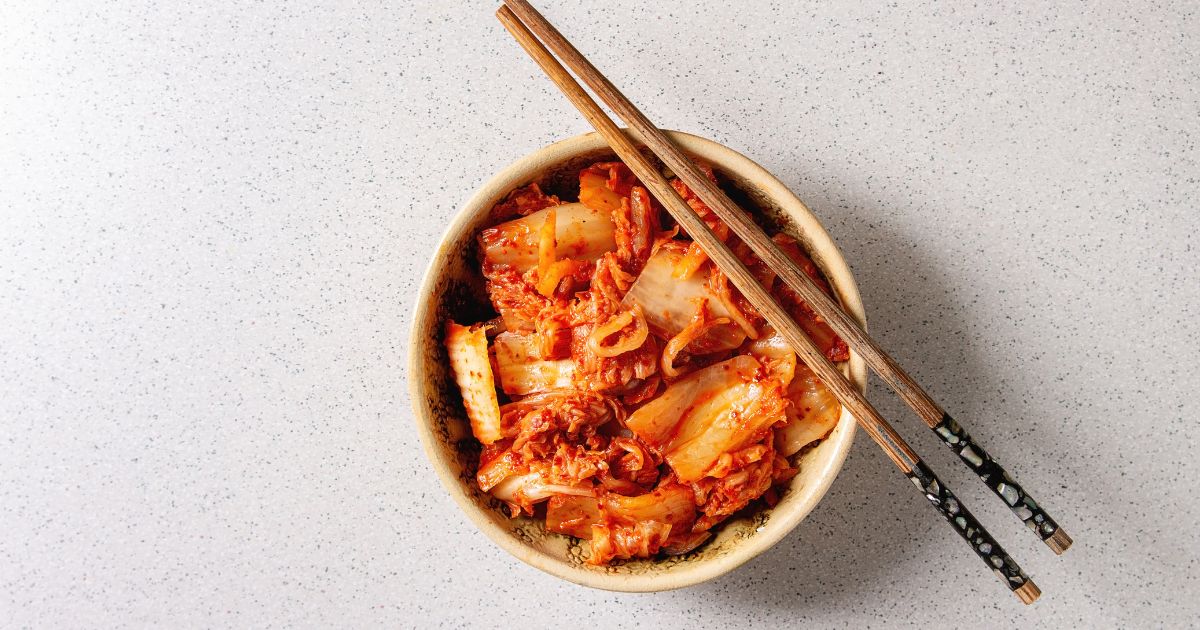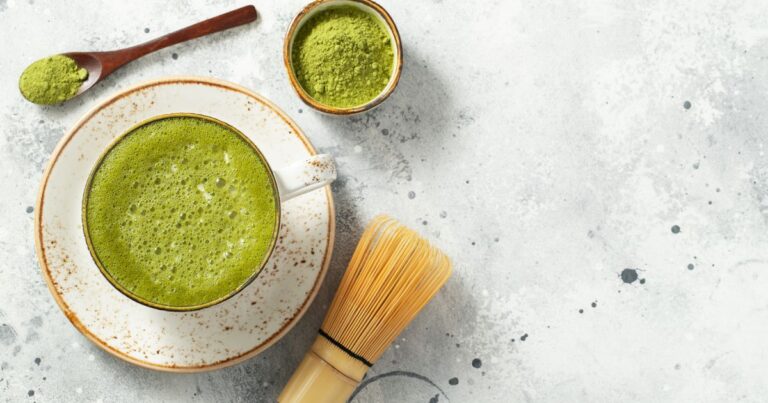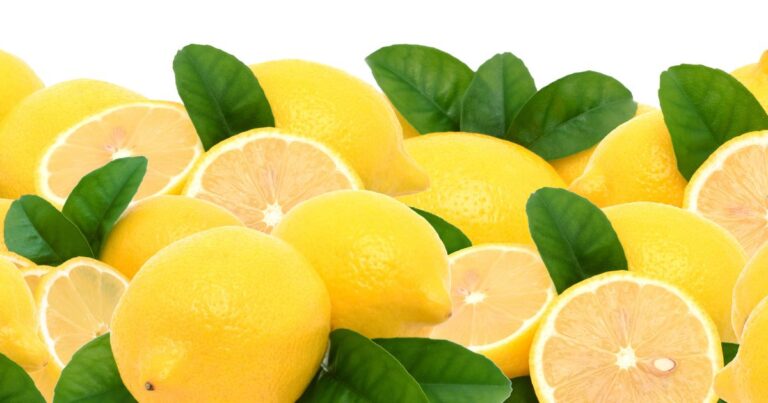The Kimchi Flavor Breakdown: Your Taste Buds and Kimchi Fried Rice
Even if you have never tasted kimchi, I’m sure you have heard about it in recent years as it’s gained popularity from its incredible health benefits with distinct tangy yet spicy flavor and texture combinations that send your taste buds into a world of confusion. What Does Kimchi Taste Like? What are these flavors? Whether you are ready to take your first bite or you are a Kimchi Fan who wants to understand the complex combination of things happening inside your mouth that you haven’t quite figured out yet, let this article be your guide, one tangy, spicy flavor crunch at a time.
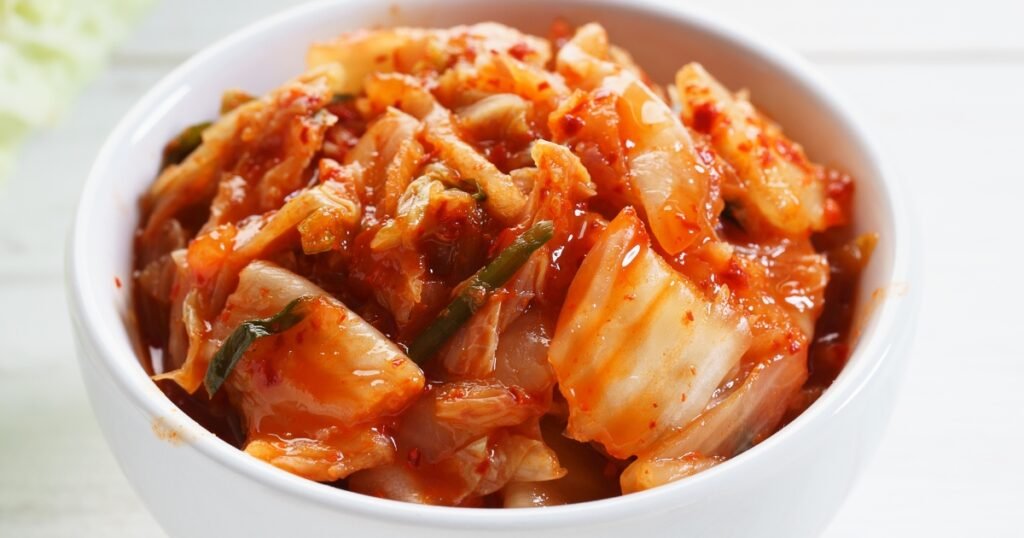
If you’ve ever wandered into the flavorful world of Korean cuisine, you’ve likely encountered this traditional Korean dish and probably have seen it in many different forms, from Salads to kimchi soup; let me tell you, it’s a stand-out star.
Picture this: a cold winter evening, a warm kitchen, and a jar of kimchi, its flavors so vibrant they practically dance on your tongue.
The complexity of its taste, the depth of its tradition, and the spicy kick that follows! So, what does kimchi taste like, you ask? Imagine a blend of crunchy vegetables marinated in a symphony of spices. Each bite is a mix of sour, spicy, and a profound umami flavor, thanks to the magic of fermentation and fish sauce.
This isn’t your ordinary side dish; it’s a centuries-old tradition that packs health benefits and flavors as rich and varied as the history of Korea itself.
Imagine diving into a dish that’s a carnival of flavors, where each bite takes you on a rollercoaster of sour, spicy, and umami notes, with a subtle hint of sweetness dancing around the edges. That, my friends, is the magic of when you eat kimchi.
Born out of necessity to preserve vegetables for the harsh winters, kimchi is a traditional Korean dish and has now become a global sensation, and for good reason.
Table of Contents
What Does Kimchi Taste Like?
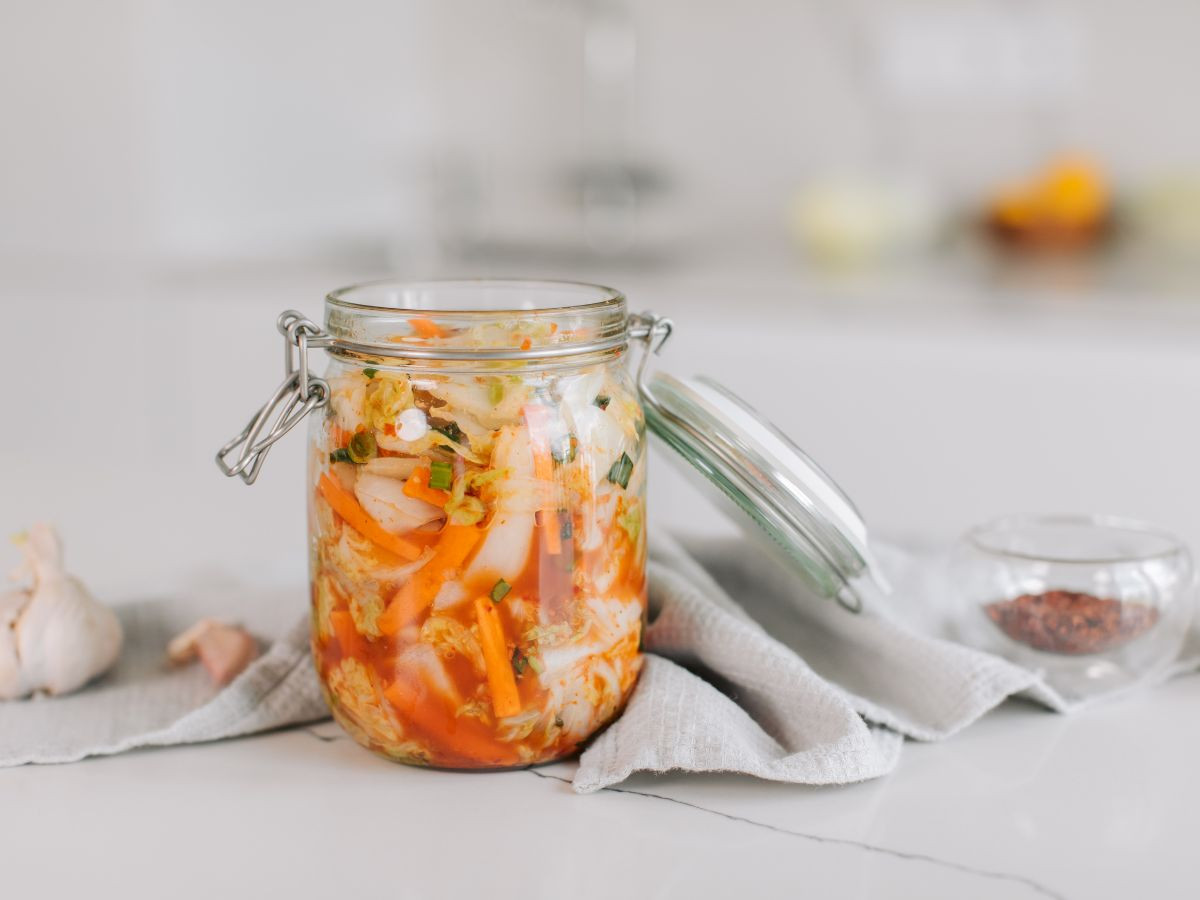
The taste of kimchi is not just food; it’s a story, a culture, and a testament to the power of fermentation. With its unique combination of fermented cabbage, radish, and a generous helping of fish sauce, among other ingredients, kimchi offers a flavor profile that’s a complex, deeply flavorful, satisfying meal and, dare I say, addictive.
But what does kimchi taste like, especially with its healthy dose of fish sauce? Let’s peel back the layers of this culinary masterpiece and find out why it’s not just food but an experience.
Flavor Profile of Kimchi
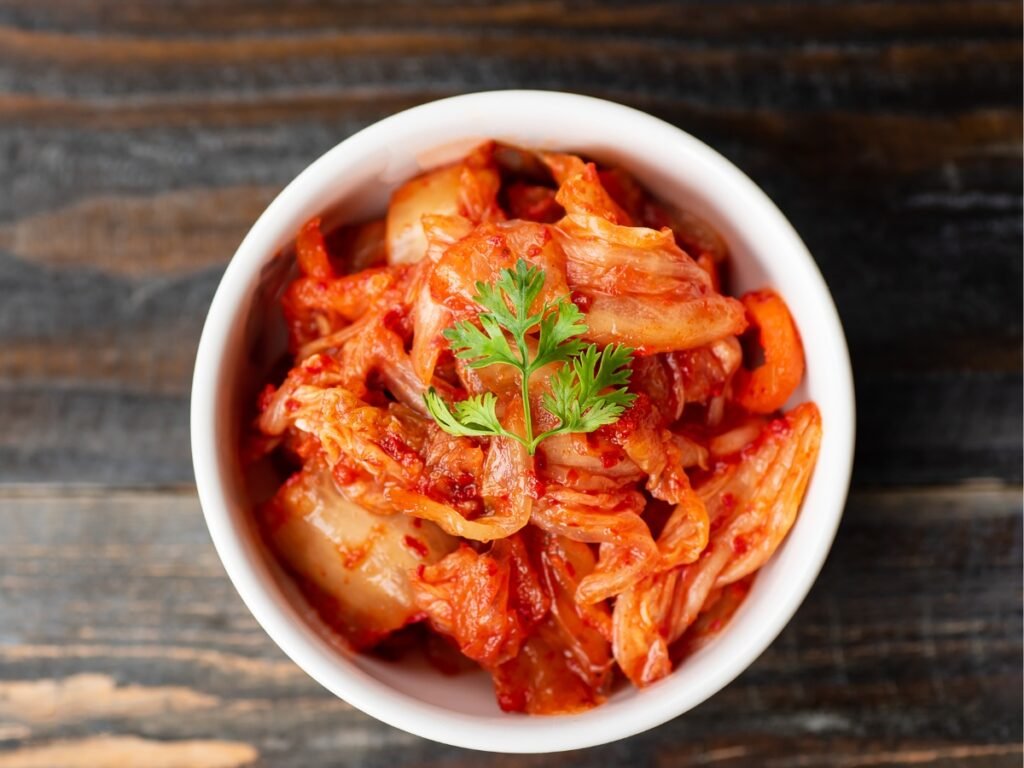
Kimchi’s flavor is as layered as its history. At first taste, you’re hit with a pleasant tanginess akin to a well-aged cheese or a freshly opened bottle of wine, thanks to the fermentation process.
This is immediately followed by a warmth that slowly spreads, courtesy of the gochugaru (Korean chili pepper flakes), which adds a spicy kick without overwhelming the senses. But the real game-changer? Fish sauce. This secret weapon introduces a deep, sea-kissed umami flavor, making kimchi not just a side dish but a showstopper.
Sour: The lactic acid fermentation gifts kimchi its signature sourness, creating a refreshing piquancy that makes your mouth water.
Spicy: Depending on the amount of gochugaru used, kimchi can range from mildly spicy to hot. This spice level adds an exciting dimension to every bite.
Umami: Here’s where the fish sauce shines. It brings a rich, savory depth that balances the sourness and heat, wrapping your taste buds in a warm embrace.
Sweet: There’s a touch of sweetness, too, often from added sugar or fruits like pear. It’s a subtle background note that complements the overall flavor harmony.
Crunchy: Beyond taste, the texture of kimchi is noteworthy. The crispness of the vegetables contrasts beautifully with the soft, chewy ferment, making each bite satisfyingly crunchy.
Simply put, kimchi tastes like a beautifully orchestrated symphony where each note is distinct yet blends harmoniously with the others. It’s a testament to the beauty of balance in cooking.
The History of Kimchi
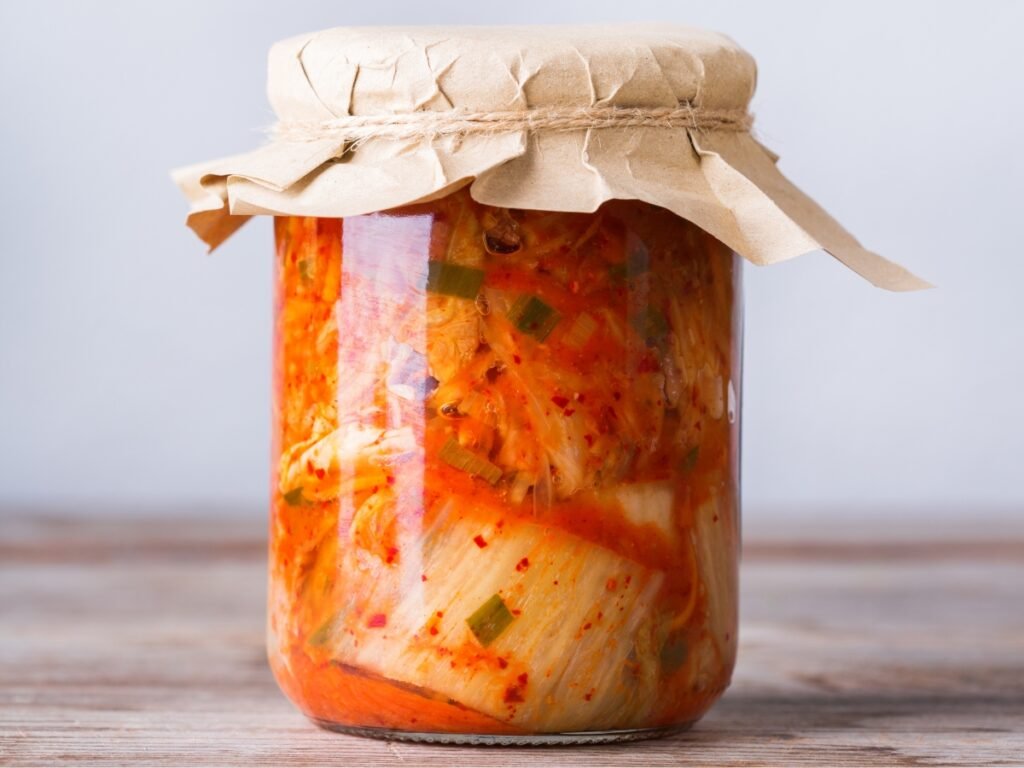
This fermented favorite dates back to ancient times when preserving food was not just essential for survival through the winters but also an art. Initially, kimchi was made by simply salting vegetables to keep them edible for longer periods.
However, as trade routes opened, new ingredients like chili peppers were introduced, and kimchi began taking on the spicy, tangy profile we know and love today.
Over the centuries, kimchi has evolved into more than a hundred varieties, each region of Korea adding its own twist based on local ingredients and tastes. The diversity is staggering, from the classic napa cabbage kimchi to the refreshing water kimchi (mul-kimchi).
This evolution speaks volumes about Korea’s rich gastronomic landscape and the ingenuity of its people in creating a dish that not only stands the test of time but also adapts and thrives.
Health Benefits of Kimchi

Kimchi isn’t just delicious; it’s a powerhouse of nutrients. This fermented wonder is low in calories yet high in dietary fiber, making it a fantastic addition to any diet. Let’s break down its health benefits:
Rich in Probiotics: The fermentation process creates probiotics, beneficial bacteria that promote a healthy gut microbiome.
Vitamins and Minerals Galore: Packed with vitamins A, B, and C, as well as minerals like iron, calcium, and selenium, kimchi is a nutritional treasure chest.
Boosts Immune System: Kimchi can help strengthen the immune system thanks to its high antioxidant content.
May Aid in Weight Loss: With its high fiber content and low-calorie count, kimchi can be a great addition to weight loss diets.
Incorporating kimchi into your diet adds a burst of flavor to your meals and contributes to your overall health and well-being.
Cooking with Kimchi
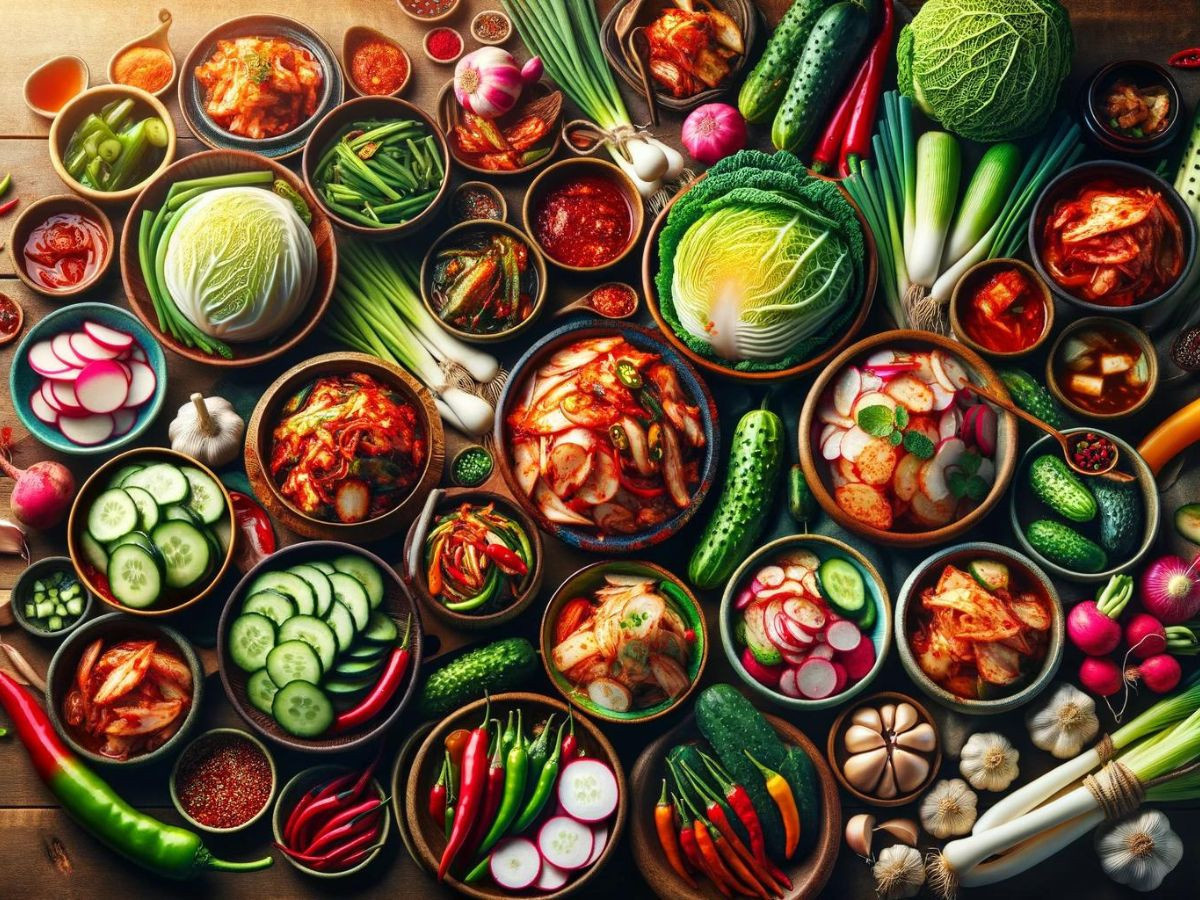
Kimchi’s versatility doesn’t end at the variety available; it extends into the kitchen, where it can transform any dish from ordinary to extraordinary. Here are some ways to incorporate kimchi into your cooking:
Kimchi Fried Rice: Elevate your fried rice game by adding chopped kimchi for a tangy, spicy kick.
Kimchi Stew (Kimchi Jjigae): A comforting, hearty stew perfect for cold days. The sourness of the kimchi beautifully complements the rich broth.
Kimchi Pancakes (Kimchijeon): Combine kimchi with a simple batter for a savory pancake that’s crispy on the outside and soft on the inside.
As a Burger Topping: Add a slice of kimchi to your burger for an unexpected burst of flavor.
Remember, when cooking with kimchi, it’s important to consider the balance of flavors. The tanginess and spice of kimchi can enhance dishes, but pairing it with ingredients that complement rather than compete with its boldness is vital.
Quick Kimchi Recipe
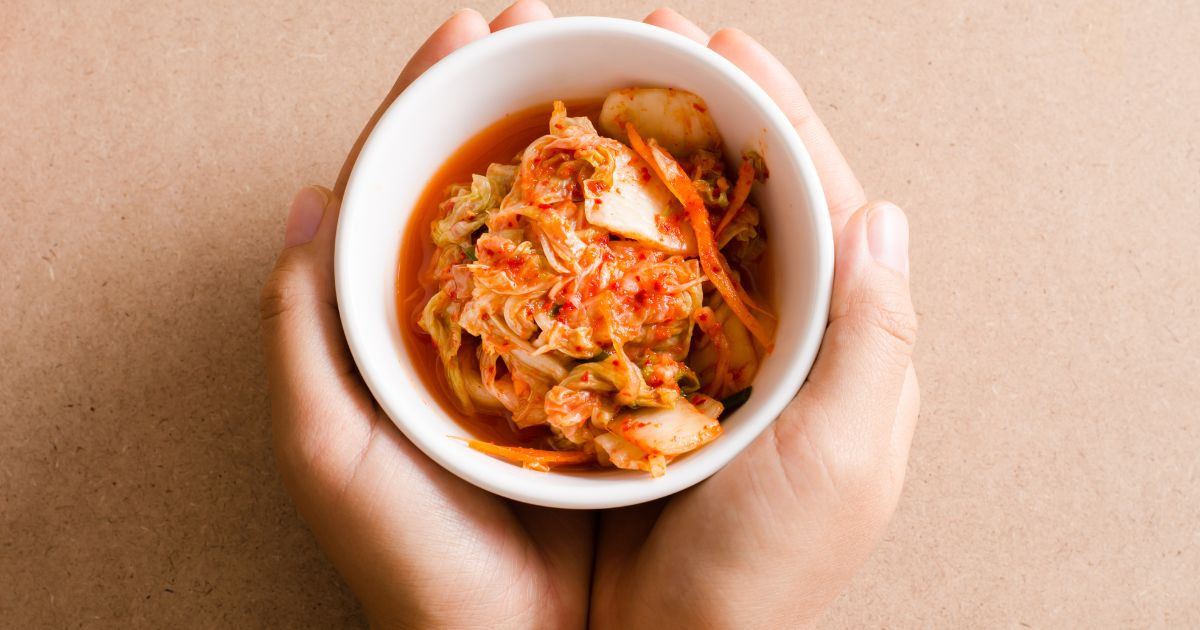
Ready to try making kimchi at home? Here’s a quick recipe to get you started. This version doesn’t require lengthy fermentation, making it perfect for beginners:
Ingredients:
1 medium napa cabbage, cut into 2-inch pieces
2 tablespoons salt
1 tablespoon grated garlic
1 teaspoon grated ginger
2 tablespoons fish sauce
1 tablespoon sugar
2-4 tablespoons Korean chili flakes (gochugaru), depending on your spice preference
4 green onions, chopped
1 medium carrot, julienned
Instructions:
Toss the cabbage with the salt and let it sit for 1-2 hours to draw out moisture.
Rinse the cabbage under cold water and drain well.
Mix the garlic, ginger, fish sauce, sugar, and chili flakes in a bowl to form a paste.
Add the cabbage, green onions, and carrot to the bowl and mix well, ensuring the vegetables are evenly coated with the paste.
Transfer the kimchi to a jar, pressing down to compact the vegetables and minimize air pockets.
Leave the jar at room temperature for 1-2 days for a slight ferment, then refrigerate.
Kimchi Beyond the Side Dish
With its vibrant taste and versatility, Kimchi transcends its traditional role as a mere side dish. It’s a global kitchen superstar, infusing meals with depth and zest. Here’s how kimchi can elevate various dishes, offering not just a health boost but an explosion of flavors:
In Soups and Stews: Kimchi adds a complex flavor base to soups and stews or even kimchi dumplings, introducing layers of tanginess and heat. A spoonful of kimchi can transform a simple broth into a rich, flavorful experience.
As a Condiment: Whether it’s topping off a sizzling burger or adding oomph to your tacos, kimchi as a condiment is a game-changer. Its spicy and acidic notes cut through the richness of meats, adding balance and brightness.
In Modern Fusion: Kimchi’s unique taste has found its way into modern fusion dishes, from kimchi quesadillas to kimchi-topped pizzas. These inventive combinations showcase kimchi’s ability to blend with various cuisines, creating new taste sensations.
Kimchi’s adaptability makes it an indispensable ingredient in the kitchen, capable of transforming the mundane into the extraordinary. It’s a testament to the creativity of cooks worldwide, who have embraced kimchi and made it their own.
What Are Different Variations Of Kimchi?
Each variation offers a unique taste experience and reflects Korea’s regional and seasonal ingredients. Let’s dive back into the colorful world of kimchi and its myriad forms.
Classic Napa Cabbage Kimchi (Baechu Kimchi)
This is the most recognized form of kimchi worldwide. Made with napa cabbage, this version is seasoned with a mix of gochugaru (Korean chili flakes), garlic, ginger, fish, soy sauce, and often daikon radish and spring onions. It strikes a beautiful balance between spicy, tangy, and umami flavors with a satisfying crunch.
Radish Kimchi (Kkakdugi)
Kkakdugi is a delightful variation made from diced Korean radish. It shares many of the seasonings used in baechu kimchi but has a distinct crunch and a slightly sweeter taste due to the radish. Kkakdugi is particularly popular as a side dish with soupy or cooked rice dishes, adding a refreshing contrast.
Cucumber Kimchi (Oi Sobagi)
Oi Sobagi is a spicy, crunchy kimchi made with cucumbers that are stuffed with seasoning. This variation is perfect for those who prefer something less fermented and more refreshing. It’s often enjoyed in the summer and can range from mildly spicy to very spicy, depending on the amount of gochugaru used.
Water Kimchi (Mul Kimchi)
Mul Kimchi is a less spicy version with a clear, refreshing broth, often featuring napa cabbage or Korean radish. This variation is particularly popular in the warmer months for its refreshing taste. It’s a testament to the versatility of kimchi, showing that not all variations are fiery or intensely flavored.
Green Onion Kimchi (Pa Kimchi)
Pa Kimchi is made primarily with green onions, offering a unique, aromatic flavor profile. It’s a great example of how kimchi can be made from almost any vegetable, showcasing the ingredient’s natural flavors enhanced by fermentation.
White Kimchi (Baek Kimchi)
Baek Kimchi is a non-spicy version made without gochugaru, resulting in a mild, refreshing taste that retains its tangy complexity. It’s ideal for those who aren’t fond of heat but still want to enjoy the probiotic benefits of kimchi.
Young Radish Kimchi (Yeolmu Kimchi)
Yeolmu Kimchi is made with young radish greens and is known for its delicate texture and slightly sweet, tangy flavor. It’s a seasonal kimchi that’s typically enjoyed in the spring and summer, highlighting the versatility and seasonal nature of kimchi making.
Stuffed Kimchi (Oisobagi Kimchi)
A variation of cucumber kimchi, this stuffed version involves filling cucumbers with a spicy mix of seasonings, including julienne carrots and radish. This method showcases the creativity behind kimchi recipes, offering a burst of flavor with every bite.
These flavors represent just the tip of the iceberg in the vast world of kimchi. Each type of kimchi has its own character and culinary uses, reflecting the richness of Korean cuisine and the ingenuity of its people.
The Cultural Significance of Kimchi
Kimchi is more than just food; it’s a cultural symbol deeply embedded in Korean life and traditions. The making of kimchi, known as “kimjang,” is a significant annual event in Korea, bringing families and communities together to prepare and share kimchi for the winter months. This tradition underscores the communal spirit of Korean culture, emphasizing sharing, caring, and preparing for the future together.
Furthermore, kimchi’s presence in every Korean meal, from breakfast to dinner, highlights its importance in Korean cuisine. It’s a staple that connects Koreans to their heritage, reminding them of the flavors of home, no matter where they are.
Sustainability and Health: The Future of Kimchi
As the world becomes more health-conscious and environmentally aware, kimchi is a sustainable food choice. Its fermentation process extends the shelf life of vegetables and enhances their nutritional value. This aligns with the growing trend towards foods that support a healthy gut microbiome, making kimchi a modern-day superfood with ancient roots.
Moreover, the sustainable aspect of kimchi, utilizing seasonal and locally available vegetables, showcases how traditional practices can contribute to a more sustainable food system. As we look toward the future, kimchi embodies the perfect blend of taste, health, and environmental consciousness.
Embracing Kimchi: A Call to Adventure
If you’ve yet to explore the world of kimchi, consider this your invitation to a culinary adventure. Kimchi is more than just a dish; it’s an experience waiting to be discovered. Whether cooking with it, enjoying it as a side, or experimenting with new recipes, kimchi promises to add flavor and a burst of joy to your meals.
Conclusion
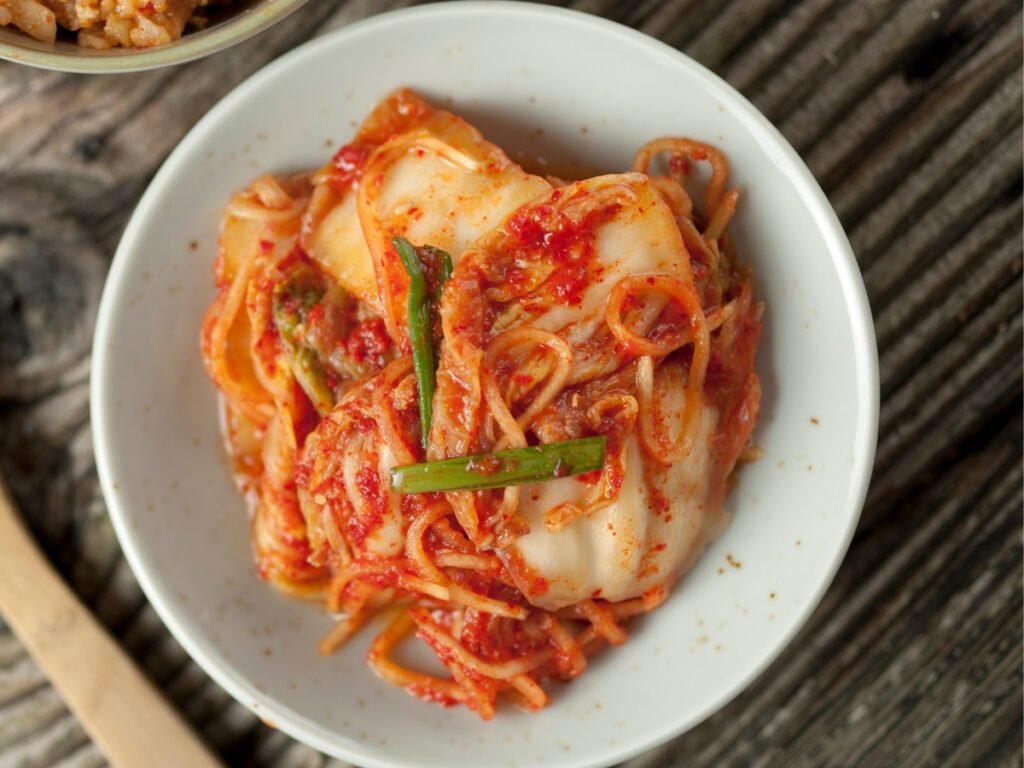
Kimchi is more than just a side dish; it’s a cultural icon, a testament to the ingenuity of Korean cuisine, and a flavorful journey that’s both complex and deeply satisfying.
What Does Kimchi Taste Like?
From its rich history to its numerous health benefits and its versatility in cooking, kimchi is a culinary treasure that everyone should explore. Whether you’re a seasoned kimchi lover or new to its unique flavor profile, there’s always something new to discover and enjoy in the world of kimchi.
So, grab a jar of kimchi (or better yet, make your very own kimchi) and let the adventure begin!
FAQ and Additional Information
What is kimchi similar to?
Kimchi, with its unique taste and fermentation process, shares similarities with several other fermented foods from around the world. While each has a distinct flavor profile and cultural significance, they all rely on fermentation to enhance taste, preserve the fermented food, and improve nutritional value. Here are a few foods that kimchi can be compared to in various aspects:
Sauerkraut
Origin: Germany
Main Ingredient: Cabbage
Flavor Profile: Sauerkraut is fermented cabbage that has a sour taste, similar to kimchi, but without the spicy and umami flavors since it typically doesn’t include chili peppers or fish sauce. Both sauerkraut and kimchi undergo lactic acid fermentation, which gives them their tangy flavor.
Sourdough Bread
Origin: Ancient Egypt, but it’s a global staple now.
Primary Ingredient: Flour and water
Flavor Profile: Sourdough bread is made from naturally fermented dough, giving it a tangy taste akin to the sourness in kimchi. The fermentation process in both sourdough and kimchi also increases the nutritional value by making vitamins and minerals more bioavailable.
Pickles
Origin: Various, with each culture having its own version.
Primary Ingredient: Cucumbers (commonly), but can include other vegetables.
Flavor Profile: Pickles made through lacto-fermentation, similar to kimchi, have a sour and sometimes spicy taste, depending on the spices used. While the base flavor of sour pickles can remind one of kimchi, pickles generally lack the complex umami and heat of chili peppers found in kimchi.
Miso
Origin: Japan
Main Ingredient: Soybeans
Flavor Profile: Miso, a fermented soybean paste, shares the umami flavor characteristic of kimchi. Both are rich in probiotics and enhance the depth of flavor in dishes. However, miso has a salty, savory taste without kimchi’s spicy and sour notes.
Kombucha
Origin: Northeast China
Primary Ingredient: Tea, sugar, and SCOBY (Symbiotic Culture Of Bacteria and Yeast)
Flavor Profile: Kombucha is a fermented tea with a tangy and slightly sweet flavor like kimchi. Although kombucha is a beverage and kimchi is a solid food, both are fermented products known for their health benefits, including probiotics.
Yogurt
Origin: Central Asia
Main Ingredient: Milk
Flavor Profile: Yogurt is fermented milk with a creamy texture and a tangy taste, which can be reminiscent of the sourness in kimchi. Both foods are fermented using lactic acid bacteria, contributing to gut health, though yogurt lacks kimchi’s spicy and umami flavors.
These comparisons highlight the diversity and commonality among fermented foods globally. While kimchi has a unique place in the culinary world with its distinctive blend of flavors, its foundational fermentation process links it to a wide array of foods that celebrate the transformation of simple ingredients into complex, flavorful, and nutritious offerings.
Is kimchi salty or Sour?
Kimchi can be salty and sour, with the balance of these flavors depending on the specific recipe, the fermentation time, and the ingredients used. Here’s a breakdown of how these tastes come into play:
Salty
The initial taste of kimchi often carries a notable salty flavor. This is because salt is a crucial ingredient in the kimchi-making process, serving multiple purposes:
Preservation: Salt inhibits the growth of unwanted bacteria during the initial stages of fermentation, ensuring that only beneficial lactic acid bacteria thrive.
Texture: Salt helps to draw water out of the vegetables, particularly cabbage, softening them and making them more pliable and flavorful.
Flavor: Salt is a fundamental flavor enhancer, bringing out the natural tastes of the ingredients.
Sour
As kimchi ferments, it develops its characteristic sour flavor. This sourness comes from the lactic acid produced by beneficial bacteria (lactic acid bacteria) as they digest the sugars in the fermented vegetables and seasonings. The longer the kimchi ferments, the more pronounced this sour flavor becomes due to the increased lactic acid concentration.
The Balance
Fresh Kimchi: Right after making, kimchi will taste more salty than sour, as the fermentation process has not yet significantly started.
Fermented Kimchi: After a few days to weeks of fermentation, especially at room temperature, kimchi develops a more pronounced sour taste, while the salty flavor becomes less dominant but still present. This is when kimchi reaches its peak complexity, offering a balance of salty, sour, spicy, and umami flavors.

